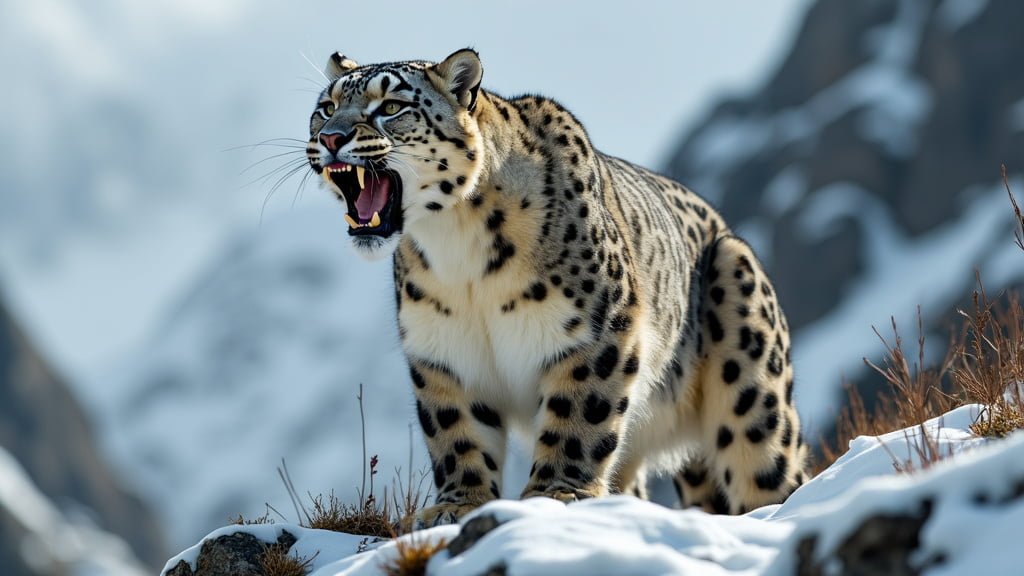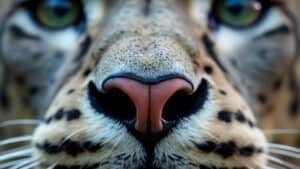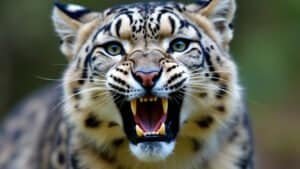Introduction
Snow leopards, elusive and solitary cats of the high mountains, communicate through a range of vocalizations that play a crucial role in their survival. Understanding how these magnificent animals use their vocal cords provides insight into their behaviors, social interactions, and reproductive strategies
This article explores the types of sounds snow leopards produce, the role of their vocal cords in creating these sounds, and how their vocalizations compare with other big cats. We’ll also review key research findings and their implications for conservation, offering a comprehensive look at snow leopard communication
Types of Vocalizations Produced by Snow Leopards
Snow leopards are known for their elusive nature, but their vocalizations offer a window into their behavior and interactions in the wild
These vocalizations are essential for communication among individuals, particularly in the vast and rugged terrains they inhabit. Unlike other big cats, snow leopards do not roar in the traditional sense, but they have a distinct repertoire of sounds that serve different purposes
Growls, Hisses, and Roars: The Basics
Snow leopards produce several types of vocalizations that are fundamental to their communication
The most common sounds include growls, hisses, chuffing, and mews. Growls are typically used as a warning signal when a snow leopard feels threatened. This deep, resonant sound can deter potential predators or intruders, signaling that the snow leopard is ready to defend itself if necessary
Hissing, another common vocalization, serves as a more immediate threat display. Snow leopards hiss when they are agitated or ready to engage in a confrontation. This sound is often accompanied by bared teeth and a defensive posture, further reinforcing the snow leopard’s readiness to protect its territory or cubs
Chuffing is a less aggressive form of vocalization used by snow leopards, particularly between mother and cubs or between mates. This sound, also known as prusten, is a friendly vocalization similar to the purring of domestic cats. It is used to strengthen social bonds and reassure other snow leopards in close proximity
Mewing is another vocalization, often heard from cubs. This high-pitched sound is a form of communication between cubs and their mother, signaling needs such as hunger or distress. Adult snow leopards may also mew softly during courtship or when interacting with their young
Unique Sounds: Non-Growl Vocalizations
In addition to the common growls and hisses, snow leopards produce several unique vocalizations that are less frequently observed but equally important in their communication repertoire
One of these is the “yowl,” a long, drawn-out sound that can be heard over long distances. Yowling is often used during the mating season, where it serves to attract potential mates and announce presence in the territory. This vocalization is particularly loud and can be mistaken for the roar of other big cats, though it lacks the same depth and resonance
Another unique sound is the “whuff,” a soft, breathy noise often made during close encounters with other snow leopards. The whuff serves as a non-threatening greeting, similar to the chuffing sound, but is less intense. It is commonly used in social interactions, particularly when a snow leopard approaches another individual in a non-aggressive manner
Seasonal Variations in Snow Leopard Vocalizations
The vocalizations of snow leopards are not static; they vary according to the season, particularly during the mating season. During this time, vocal activity increases significantly as males and females search for potential mates
Yowling becomes more frequent, serving as both a mating call and a method of asserting dominance over a territory. The increase in vocal activity during the mating season is crucial for successful reproduction, as snow leopards are solitary animals that must locate each other in vast and rugged landscapes
Cubs, too, become more vocal as they grow, especially when they begin to explore their surroundings. Their mewing evolves into more varied sounds as they learn to communicate more effectively with their mother and siblings. The development of these vocalizations is essential for their survival, as it helps them to express needs, signal danger, and eventually, communicate with potential mates
The Role of Vocal Cords in Snow Leopard Communication
Snow leopards rely heavily on their vocal cords to produce a variety of sounds crucial for communication in their harsh mountainous environments. The anatomy of their vocal cords plays a significant role in how these sounds are generated, offering insights into the unique ways snow leopards interact with each other
Anatomy of Snow Leopard Vocal Cords
The vocal cords of snow leopards are similar in structure to those of other big cats but have adapted to produce a distinct range of sounds. Snow leopards possess a pair of vocal cords located in the larynx, or voice box, at the top of the trachea
These vocal cords are made of muscle, connective tissue, and a layer of mucous membrane, allowing them to vibrate when air passes through the trachea during exhalation
One unique aspect of snow leopard vocal cords is their relatively smaller and more elastic nature compared to those of larger felids like lions or tigers. This elasticity is crucial for producing the high-pitched and softer sounds characteristic of snow leopards, such as mews and chuffing
Unlike lions, whose vocal cords are designed for producing loud roars, snow leopards have adapted to generate a wider range of softer, more subtle sounds that suit their solitary and secretive lifestyle
How Vocal Cords Produce Different Sounds
The production of sound in snow leopards begins when air from the lungs passes through the trachea and reaches the vocal cords in the larynx. As the snow leopard exhales, the vocal cords come together and vibrate, creating sound waves. The pitch and tone of these sounds are determined by the tension, length, and elasticity of the vocal cords
For instance, when snow leopards produce a growl, the vocal cords are tensed and stretched to create a lower frequency sound. This deep growl is made possible by the contraction of muscles within the larynx, which tighten the vocal cords, allowing them to produce the low, resonant sound characteristic of a growl
In contrast, sounds like mews or chuffing are produced when the vocal cords are less tense, allowing them to vibrate at a higher frequency, resulting in a higher-pitched, softer sound
The vocal cords also play a crucial role in the production of the yowl, a sound commonly associated with snow leopards during the mating season. To produce this sound, snow leopards utilize a combination of vocal cord tension and air pressure, allowing them to generate a loud, far-reaching call that can be heard across the rugged landscapes they inhabit
The ability to adjust the tension and length of the vocal cords gives snow leopards the versatility to produce a wide range of vocalizations necessary for various social interactions
Vocal Cord Function During Mating Season
During the mating season, the vocal cords of snow leopards are put to extensive use as these solitary cats communicate with potential mates
The yowl, in particular, is a vocalization that becomes more prominent during this period. This sound serves as both a mating call and a territorial signal, indicating the presence and readiness of the snow leopard for reproduction
The vocal cords’ ability to produce such a powerful and resonant sound is essential for attracting mates over large distances. The rugged, mountainous habitats of snow leopards often require that these vocalizations travel far to reach other individuals
The yowl’s deep, carrying tone is perfectly suited for this purpose, and the vocal cords are adapted to sustain this vocalization for longer periods without strain
Furthermore, the mating season also sees an increase in softer, more intimate sounds like chuffing and whuffing, which are used during close encounters between potential mates. These sounds, produced with less tension in the vocal cords, help to build rapport and reinforce social bonds
The flexibility of the vocal cords allows snow leopards to switch seamlessly between these different vocalizations, depending on the context and distance between individuals
Comparison of Snow Leopard Vocalizations with Other Big Cats
Snow leopards share some vocalization traits with other big cats, but they also exhibit unique characteristics that reflect their adaptation to a solitary and high-altitude lifestyle. By comparing their vocalizations with those of other felids, we can better understand the evolutionary and ecological factors that shape their communication
Similarities Between Snow Leopards and Other Felids
Snow leopards, like many other big cats, use a variety of vocalizations to communicate. These vocalizations include growls, hisses, and mews, which are common across the Felidae family
Growling is a universal signal among big cats, often used as a warning or to assert dominance. Snow leopards growl similarly to lions, tigers, and leopards, using their vocal cords to produce a low-frequency, resonant sound that can intimidate rivals or predators
Hissing is another vocalization shared among big cats. It serves as an immediate threat display and is typically used when an individual feels cornered or in danger. The hiss of a snow leopard is quite similar to that of a tiger or a jaguar, where the vocal cords create a sharp, high-pitched sound that is often accompanied by a defensive posture
Mewing, although more commonly associated with cubs, is also a vocalization found in other big cats. Lion and tiger cubs, for example, mew to communicate with their mothers, much like snow leopard cubs. These high-pitched calls are essential for maintaining the bond between mother and offspring and ensuring the cubs’ needs are met
Unique Vocal Characteristics of Snow Leopards
Despite these similarities, snow leopards have developed several unique vocalizations that set them apart from other big cats. The most notable difference is their inability to produce a true roar
Unlike lions, tigers, and leopards, which can produce a full-throated roar thanks to a specialized larynx structure, snow leopards lack the thick, flexible cartilage in their larynx necessary to create such a powerful sound. Instead, snow leopards produce a sound known as a “chuff” or “prusten,” which is more subdued and serves a different social function
The chuffing sound, while present in tigers as a friendly greeting, is much more prominent in snow leopards, where it is used frequently between mothers and cubs or between mates. This sound, produced with a relaxed larynx and vocal cords, is crucial for social bonding in snow leopards, especially given their solitary nature
Another unique vocalization of snow leopards is the yowl, a long, moaning call used primarily during the mating season
While other big cats like lions and tigers also produce long-distance calls during mating, the yowl of a snow leopard is distinct in its tone and pitch, designed to carry across the vast, mountainous landscapes they inhabit. This adaptation is vital for locating potential mates in the expansive and sparsely populated regions where snow leopards live
Evolutionary Significance of Snow Leopard Vocalizations
The unique vocal characteristics of snow leopards can be understood through the lens of evolution. Snow leopards evolved in the rugged, high-altitude regions of Central Asia, where their solitary lifestyle and the vast distances between individuals required a different approach to communication
The inability to roar may have been an evolutionary trade-off, favoring stealth and subtlety over the loud, attention-grabbing roars of other big cats
The development of the yowl, chuff, and other soft vocalizations is likely an adaptation to the snow leopard’s environment, where long-distance communication is essential, but the harsh terrain limits the effectiveness of loud roars
These vocalizations are optimized to carry over the specific frequencies that travel best in mountainous regions, allowing snow leopards to communicate effectively without drawing unnecessary attention to themselves
Moreover, the emphasis on softer sounds like chuffing and mewing reflects the snow leopard’s need for social bonding in an otherwise solitary existence. These sounds play a critical role in maintaining the essential relationships between mothers and cubs and between mates, ensuring the survival and continuity of the species
Research on Snow Leopard Vocal Communication
Scientific research on snow leopard vocal communication has significantly advanced our understanding of how these elusive big cats interact with one another in their natural habitats
Through a combination of field studies, acoustic analysis, and technological advancements, researchers have uncovered vital information about the sounds snow leopards produce and their roles in the species’ survival
Key Studies and Findings
One of the most comprehensive studies on snow leopard vocalizations was conducted by Miquelle et al. (2005), who focused on analyzing the variety and frequency of sounds made by snow leopards in both wild and captive environments
This study identified several distinct vocalizations, including growls, hisses, chuffing, and yowls, and documented their specific contexts. The research highlighted the importance of yowling during the mating season, noting that this vocalization plays a critical role in mate attraction and territorial defense
Another important study by Nyhus, McCarthy, and Mallon (2016) explored the comparative aspects of snow leopard vocalizations with other big cats. Their work emphasized the unique adaptations of snow leopard vocal cords, particularly in producing non-roaring sounds like chuffing and mewing
The study provided insights into how these vocalizations have evolved to suit the snow leopard’s solitary and high-altitude lifestyle
In addition, a field study conducted by the Snow Leopard Trust in collaboration with the Wildlife Conservation Society (WCS) utilized remote acoustic monitoring to capture and analyze snow leopard vocalizations in the wild. This research employed automated recording devices placed in key habitats, allowing scientists to collect extensive data on vocal behavior over time
The findings from this study revealed new aspects of snow leopard communication, such as variations in vocalization patterns based on time of day and environmental factors
Technological Advances in Vocalization Research
Recent technological advances have greatly enhanced the ability of researchers to study snow leopard vocalizations. High-quality recording equipment, combined with automated acoustic monitoring systems, has enabled scientists to capture vocalizations in remote and rugged environments where snow leopards reside
These technologies allow for continuous monitoring over extended periods, providing a more comprehensive understanding of snow leopard communication
Acoustic analysis software has also played a crucial role in advancing research. By analyzing the frequency, duration, and amplitude of snow leopard sounds, researchers can distinguish between different types of vocalizations and determine their specific purposes. This level of detail is essential for understanding the nuances of snow leopard communication and how it relates to their behavior and ecology
Moreover, advances in bioacoustic research have allowed scientists to study the vocal communication of snow leopards in relation to their genetics and evolutionary history. By comparing the vocalizations of snow leopards with those of other big cats, researchers can gain insights into the evolutionary pressures that shaped the development of specific sounds and their roles in survival and reproduction
Implications for Conservation Efforts
Understanding the vocal communication of snow leopards is not just of academic interest; it has significant implications for conservation efforts. As snow leopards are classified as vulnerable by the International Union for Conservation of Nature (IUCN), effective conservation strategies are critical for their survival
By studying vocalizations, conservationists can gain insights into the behavior, social structure, and population dynamics of snow leopards, which are essential for designing effective protection measures
For instance, monitoring vocalizations can help identify key mating periods and locations, enabling conservationists to focus their efforts on protecting critical habitats during these times
Additionally, understanding the role of vocal communication in territory establishment can inform strategies to reduce human-wildlife conflicts, particularly in areas where snow leopard habitats overlap with human settlements
Furthermore, vocalization research can aid in population monitoring. The ability to identify individual snow leopards based on their vocal signatures allows for more accurate population estimates and tracking of movements within and between habitats
This information is vital for assessing the health of snow leopard populations and the effectiveness of conservation interventions
Conclusion
Snow leopards, with their unique vocalizations, demonstrate a remarkable adaptation to their solitary and rugged environments. Their vocal cords produce a range of sounds, from growls and hisses to softer chuffing and mews, each serving a specific purpose in communication
Unlike other big cats, snow leopards do not roar; instead, they have developed a repertoire of sounds that are better suited to their high-altitude habitats. Research has shown that these vocalizations are crucial for mating, territory defense, and social bonding, especially during the mating season
Scientific studies have provided valuable insights into how these sounds are produced and their significance in the snow leopard’s life. Technological advancements have further enhanced our understanding, allowing researchers to monitor these elusive cats in their natural habitats and gather data critical for conservation efforts
By continuing to study snow leopard vocalizations, we can better protect this vulnerable species and ensure that their calls continue to echo through the mountains for generations to come













